Banish these seven bad habits from your apparel photography workflow
The e-commerce industry changes constantly. However, although trends come and go with each season, there are a few things that must remain the same—especially in apparel photography. In this post, we will identify seven big mistakes that many product photographers make and discuss how to avoid them to create stunning inventory images!
Mistake #1: Not preparing the garment
You want your products to look their best so that you can showcase them to customers. Unfortunately, clothing can become wrinkled and creased, and begin to look worn from storage and transport. Sometimes, clothing samples are even received in old, tattered, or even unfinished conditions!
Preparing garments to be photographed is a crucial starting point for photographing apparel, and yet many apparel photographers skip this step and prefer to rely on Photoshop to fix wrinkles, stains, and other undesirables accrued while storing or transporting the product.
Photoshop isn’t magic; it takes time and expertise to master advanced editing techniques, and all edits that you make are “destructive” to the image, compromising some image quality. Because of this, it’s best to rely on Photoshop only to add final touches and colour correction to your images and ensure that you capture the garment as perfectly as you can in camera.
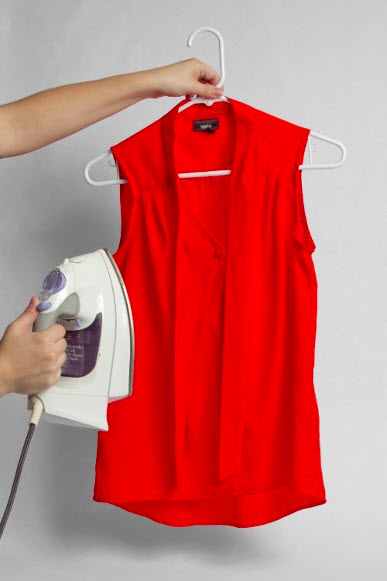
Take care of your product and make it look its best before photographing it.
It’s important to thoroughly examine your product from top to bottom, inside and out. Are there any tags, stickers, and other types of identifying materials that need to be removed? Do so. Has the product become wrinkled or creased during storage? Iron or steam it.
Use the resources that are available to you to fix other damages and distractions that you might come across. In particular, lint rollers and tape are great for removing dust and strings from fabrics.
In some cases, samples are wrong upon arrival due to last-minute design changes (e.g. fit, colours, patterns, etc.). Make sure that you understand design changes for each garment so that you can edit the sample accordingly in Photoshop or make the decision to wait to photograph the actual sample that will be sold.
Mistake #2: Not utilizing a mannequin or live model
Many apparel photographers overlook the importance of communicating shape and fit to customers by photographing garments being worn by mannequins or live models. Instead, they simply lay clothing flat or photograph it on hangers. This is a huge mistake!
Photographing a garment on a mannequin or a live model is perhaps the best way to showcase that garment’s shape and encourage customers to visualise it being worn by themselves.
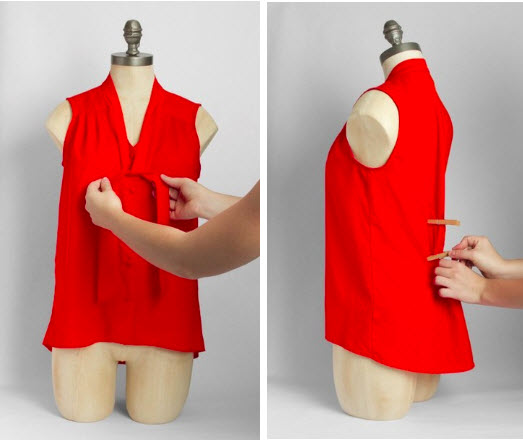
With a little styling, mannequins can really flatter your products!
Models make clothing come to life, but when models can’t be used due to budget or time constraints, a mannequin is the next best thing you can use with a very low budget. Allowing the customer to see the shape and natural draping of each product will give them a realistic idea of how the garment will fit on them—not to mention a higher quality shopping experience.
A little styling can go a long way, too. If your garment seems to be too big for your mannequin, try fitting it closer to your mannequin by pinning it and tucking your garment so that it is styled to fit properly. Photographing your products on mannequins also allows you the opportunity to create a classy post production technique called the ghost mannequin effect.
Mistake #3: Not providing enough imagery
Contrary to popular belief, one or two images of each product is simply not enough to give customers an accurate feel for the quality of your inventory. Therefore, it’s important to give customers as much information as possible about each product by uploading at least 3 images per product—and preferably 5-10.
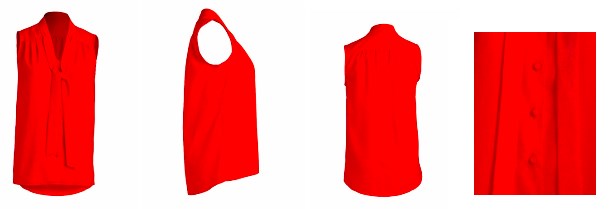
Uploading more images will give customers more confidence in your product.
In ePages, you have an unlimited number of images you can upload to your product gallery/slideshow (as long as they have a width less than 1920 px and a height less than 1080 px), but many retailers don’t take advantage of this extra opportunity to promote their products. Whenever possible, photograph as many angles of your products as possible. At the very least, photograph the standard front, side, and back view of each product, and then supplement that with close-ups of important product embellishments, such as buttons, zippers, or embroidery.
The more images of your product you upload, the more the customer will come to understand about the product. This will provide them with a better shopping experience and demonstrate the quality of your products, as well as ensure that the customer is satisfied when the product arrives. To get ideas about additional ways to photograph products, read our Ultimate Guide to Maximise your Apparel Product Listing.
Mistake #4: Not utilizing enough light
Don’t be that e-commerce retailer whose product images look dingy and underexposed. Bright lighting should be one of your biggest concerns as an online apparel retailer. Ensuring that you expose images correctly will showcase products’ colours and other details accurately, as well as make your inventory appear clean and professional.
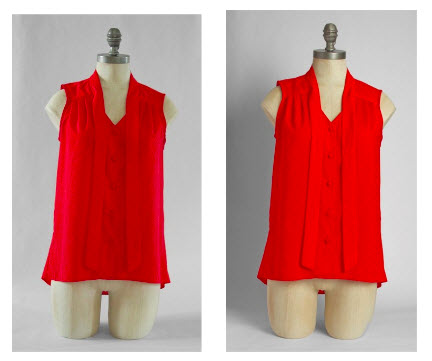
Not very good lighting. Light from a lit room. / High Quality Lighting – Lighting Kit Lit
All clothing is different and having the right lighting will allow customers to appreciate the unique facets of your garments. Ample lighting also allows your camera to produce higher quality images with less “noise” or “grain” and more sharpness. The darker the lighting situation, the poorer the image quality—and poor image quality will not flatter your products!
The most flexible way to ensure that you have sufficient lighting is to rent artificial lighting equipment, but in the event that renting equipment is not in your budget, try using natural light from a large window and a reflector panel made from foam board.
Mistake #5: Not using the correct camera settings
If your camera settings are wrong, then no amount of Photoshopping expertise will be able to make your images look professional. DSLR cameras can produce photographs of extremely high quality, but incorrect settings can drastically reduce that quality. Make sure that you understand ISO, aperture, and white balance before you photograph your products.
1. ISO
Make sure that your ISO is no greater than 600-640. Higher ISOs produce distracting “noise” or “grain,” which are grayish or coloured speckles that make photographs look more filmic. The higher you go, the worse the noise will be. More than that, at higher ISOs, the camera can’t capture as much sharpness, so details begin to look soft. Using a tripod will allow you to keep your ISO at 100 or 200 for optimal clarity and sharpness.
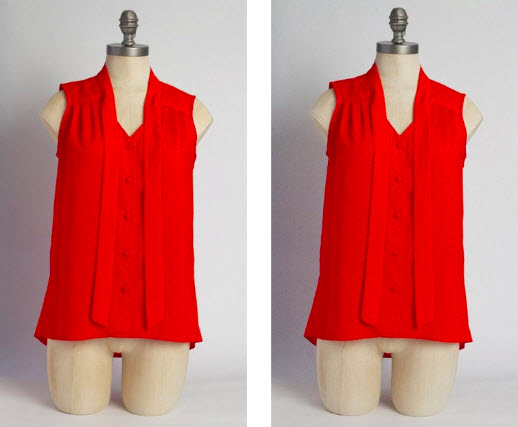
ISO 640 / ISO 6400
2. Aperture
Aperture, which is represented by the f number of your camera settings (e.g. f/16, f/2.8) controls focus. Generally, the larger the aperture number, the more aspects of the image will be in full focus. In our above example, more of the garment is sharper at f/22 than it is at f/3.5. Thus, make sure to set your aperture higher than f/11; this will allow for all aspects of your products to be in complete focus.
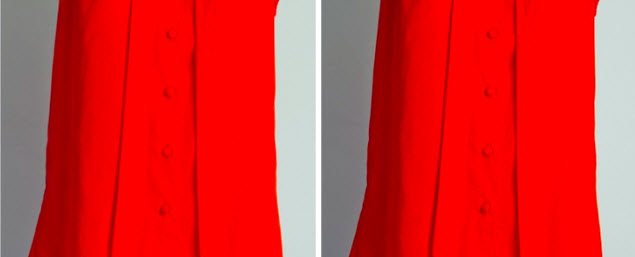
Aperture 3.5 / Aperture 22
3. White Balance
White balance refers to the colour cast of the image. Orange and red hues are generally referred to as being “warmer,” with purple and blue hues as “cooler.” The colour cast of an image depends on the light source being used and the camera’s white balance setting, which controls how the camera interprets the colours that it records. There are many different types of light sources, but the most common are tungsten, fluorescent, LED, and natural sunlight.
You can set your white balance specifically according to the type of light source that you are using or set your white balance to AUTO and let the camera decide. Whatever you choose, don’t forget about white balance or you may find yourself hard-pressed to try to recreate accurate colours in Photoshop. For more help with setting your camera, check out our articles on ISO, and general manual camera settings.
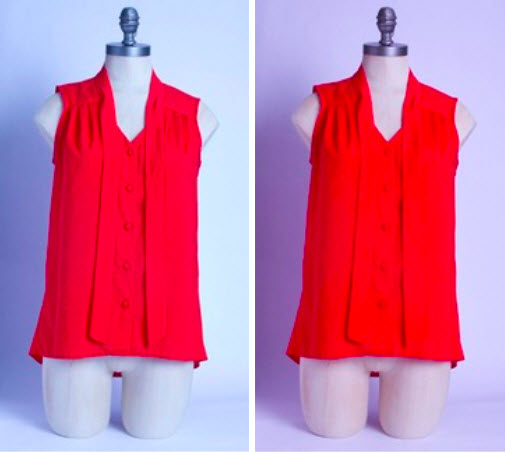
Tungsten / Fluorescent
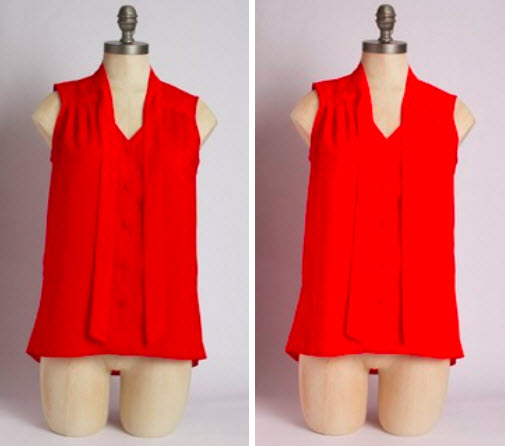
Flash / Auto
Mistake #6: Not setting the correct colour space profile
Many apparel photographers forget or don’t know about the very crucial step of converting edited photos into a web-ready colour space profile. Colour space is a specific range of colours that can be presented in a given image. Some options for colour spaces are Adobe RGB, CMYK, and SRGB. Without the correct colour space, colours of products will look totally different when viewed on different computer screens, web browsers, and even websites.
SRGB is the best colour space profile to keep your images consistent and vibrant between the various screens, browsers, and sites. You can choose to set your camera to SRGB, thus eliminating the extra step of converting the file to SRGB after you edit it. However, SRGB captures a narrower range of colours than your camera’s RGB default, so many professionals choose to make the conversion only after they have perfected their images to avoid limiting their editing capacity.
Mistake #7: Not editing properly
Many e-commerce retailers edit their product images improperly, especially with regards to cropping, alignment, colour, and backgrounds. It’s best to keep all crops, alignments, and backgrounds identical from image to image in your inventory. To keep all images consistent in relation to one another and cut back your post-processing time, make sure to develop a standard set of specifications for both shooting and how you edit your images.
1. Alignment
Make sure that your products are all the same size and are centered within your image so that all of the angles, corners, and edges of your products line up in relation to one another. Having consistently aligned inventory will absolutely boost the appeal of your website and products. The easiest way to ensure that your alignment is spot on is to create guidelines in a Photoshop template.
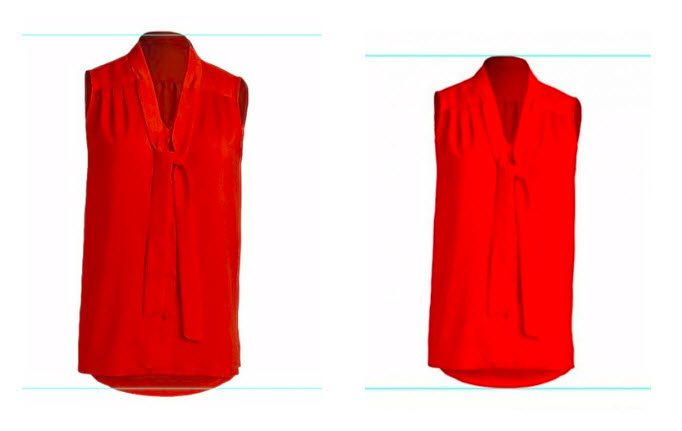
Use Photoshop templates to align your product images.
2. Cropping
Similar to alignment, it is imperative that you crop product images identically so as to provide the customer with a seamless online shopping experience. If you use guidelines for alignment, then cropping consistently and sizing images according to your website’s image specifications should be no problem.
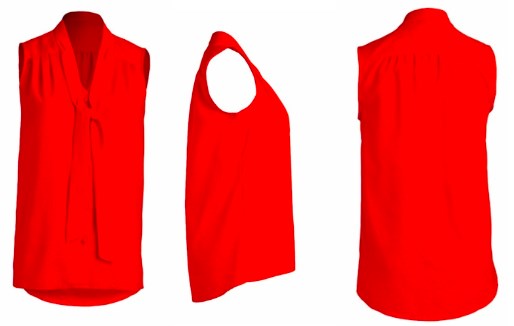
Cropping images consistently provides your customers a seamless shopping experience.
3. Backgrounds
Some e-commerce companies choose different backgrounds to display different products. Although this may seem unimportant, keeping all of your product images consistent in relation to one another can drastically improve the professionalism and appeal of your website and inventory selection. Choosing one background style and sticking to it can also shave off post-production time. It is generally agreed upon that white or light grey backgrounds are the most appealing.
4. Colours
Another common mistake in apparel photography is inaccurately representing garments’ colours. Although the camera does a great job creating fairly-accurate colouring if you allow it to decide white balance for itself with AUTO mode, some colours—such as neons, reds, and pinks—are difficult to photograph correctly in camera and often need to be tweaked in Photoshop.
Converting images to SRGB will provide ensure that your product’s colours are accurate.
Inaccurate representations of colours can leave customers frustrated and dissatisfied, so taking a few extra minutes to ensure that the colours of your garments are accurate before you upload them to your website is a good idea. The bottom line is that you want the customer to see exactly what they will receive in the mail should they order your product.
There are a number of ways to tweak colours, so get to know Photoshop’s offerings and choose your favorite tool. After you have fixed the colours, make sure to convert your images into SRGB format so that different browsers, computer screens, and websites won’t change the accurate colours that you worked so hard to create for your customers.
How to improve your images
Now that you know the 7 most common mistakes in apparel photography, you have the opportunity to improve your workflow and create wonderful product images for your customers. To optimise your post-production processing and reduce studio-to-web lead time, consider using Pixelz. Professional image editing at scale will remove bottlenecks and allow you to focus on being creative.
To use Pixelz, please visit the ePages App Store in your shop’s administration area. Select Apps & Themes and then App Store. The app needs to be available in the shop package you chose at your provider.
ist Business Development Manager Germany bei Sage Pay. Er verfügt über langjährige Erfahrungen in der Finanzbranche mit Schwerpunkt auf den bargeldlosen Zahlungsverkehr. Seine Karriere begann er bei der Eurocard Service GmbH, wo er schnell zum projektverantwortlichen Key Account Manager aufstieg. Als Business Development Manager bei First Data International im Bereich Mobile Solutions entwickelte und vermarktete er neue Zahlungsmethoden. Er machte sich auch einen Namen als freier Berater für Banken, Zahlungsanbieter oder Kartenorganisationen und begleitete Projekte, welche die Zahlungsfunktionalitäten am POS, im E- und M-Commerce unterstützten.
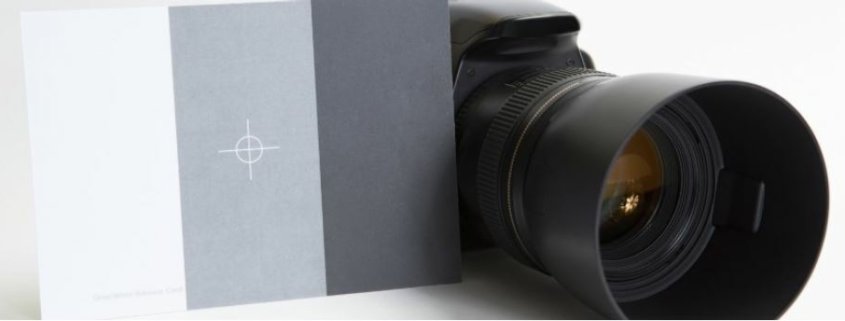



Leave a Reply
Want to join the discussion?Feel free to contribute!